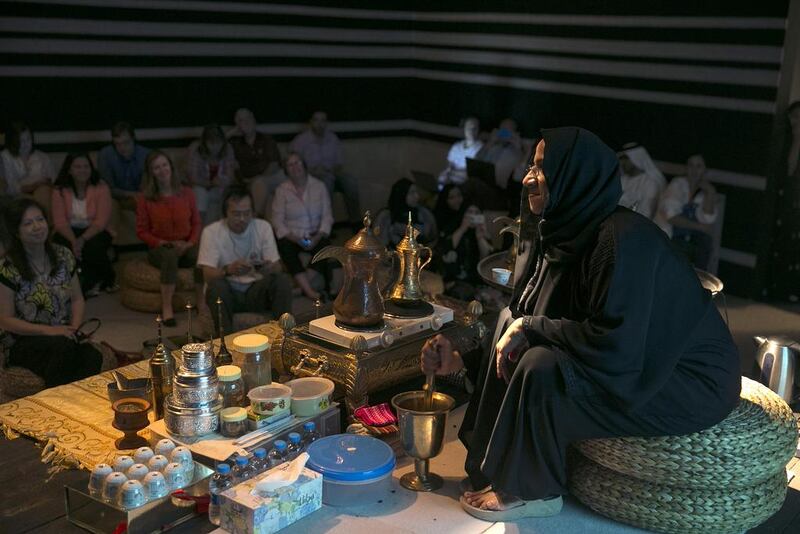A goat herder is said to be the first person to discover the stimulating effect of the beans. Muslim pilgrims introduced the berries to this country. Since then, Emiratis have made an art out of preparing and enjoying the drink.
Ghaya Khalfan Al Dhaheri is a storyteller. And her favourite story is best told over a cup of coffee.
Mrs Al Dhaheri is an expert on coffee, or gahwa in Arabic.
At a recent event organised by Abu Dhabi Tourism and Culture Authority, the researcher at the authority gave a talk about how human beings discovered the stimulating beverage.
A long time ago, an Ethiopian goatherd set out to graze his animals and left them beside a bush that was full of berries.
He later found that the animals were unusually lively at the end of the day. He realised that the berries were the cause.
After trying one, “he felt as though an electric current was coursing through his body”, says Mrs Al Dhaheri.
After tasting the coffee beans, he found that they boosted his energy level.
The goat herder shared his discovery with his fellow villagers, one of whom accidentally dropped some beans into a fire and discovered the delicious taste and aroma of roasted coffee.
After brewing the roasted coffee beans with water, they found that the beverage gave them energy to stay awake for midnight prayers.
Telling the story in the company of coffee pots (known as dallah in Arabic), cardamom, cumin and other items for making Arabic coffee, Mrs Al Dhaheri says Sufis in Yemen and pilgrims to Mecca also drank coffee to keep awake and worship late into the night when others were asleep.
Muslims returning from the Haj brought coffee with them to what is now the UAE. “The Arabs in the Arabian Peninsula and the Gulf embraced this new product,” she says.
Coffee soon began to spread from the Arabian Peninsula to Europe through trade.
It became a symbol of hospitality at palaces, homes, social gatherings and celebrations.
Over the years, people experimented with coffee. “People noticed that adding cardamom, saffron, cloves and oud gave the coffee another exquisite taste,” says Mrs Al Dhaheri.
On the etiquette of coffee drinking, she asks the audience: “Have you wondered why we hold the dallah in our left hand and smalls cups with no handle on the right, not the other way?”
The answer lies in a photograph projected on a screen behind her. “The picture was taken in 1902,” she says. “It shows Zayed bin Khalifa relaxing with his family and guests.”
In the picture, the man serving the coffee, the muqahwi, holds the dallah in his left hand and small cups on his right. Emiratis have been following his example to this day.
Dallah can be made from copper and iron, or precious metals. Raising a dallah that Mrs Al Dhaheri says was used by Sheikh Zayed, the founding father of the UAE, she notes that “it is made of gold”.
Not everyone could serve coffee to members of the royal family and dignitaries. A prospective muqahwi had to pass a test. To do so, a person had to know Arab culture and traditions, be good-looking, strong and have a reputable personality.
“Many secret talks would take place while the host pours coffee for dignitaries and royals,” says Mrs Al Dhaheri.
So the muqahwi should be discreet when he leaves the majlis, and for good reason. “If he dared to reveal any secrets, he would be executed,” she says.
For Arabic coffee, there is a form of communication. To inform his guest that “gahwa has arrived”, the muqahwi gestures to his guest, or in some cases he gently clinks the small cup with the dallah.
“People are busy talking in the majlis and palaces. So etiquette dictates that the muqahwi does not interrupt the discussions, using gestures instead,” says Mrs Al Dhaheri.
In serving up coffee, it is not necessary to fill the cup because coffee is not consumed to quench thirst but to instil joy and happiness, she says
When the muqahwi offers coffee, he should bend forward to serve it to the guest. The thimble-shaped cup should be held with fingers on the base of the cup and the thumb on the edge of the rim.
Marriage proposals, treaties and financial aid were all part of the language of coffee, says Mrs Al Dhaheri.
As with dallah, there are different kinds of coffee cups. “One type is called ‘funjan al tallab’, meaning ‘the cup of demand’, which is for asking a woman’s hand in marriage,” she says.
“So a royal man would signal his interest in marrying another royal’s daughter in the royal’s majlis from the manner he put the cup.
“Sheikh Zayed composed a few poems about coffee. In this poem, he is addressing his beloved to make coffee for him in a beautiful manner.”
Oh, well-mannered one
Polite nature and courtesy
Go make me a cup of coffee
And add what you feel like
adding
Oh, the light of my eye, you are like nobody else
And I can’t love no one but you
Your sight takes away grief
And your pretty smile lines.
AAlHameli@thenational.ae






